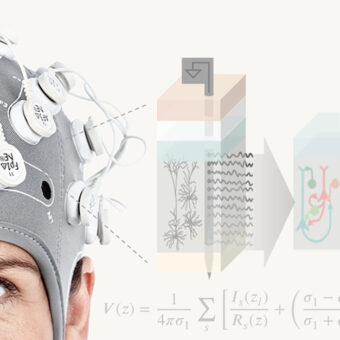©neuroelectrics
As I explained in one of my previous posts, a Brain Computer Interface (BCI) is a direct communication pathway connecting the brain to a computer or other external device. BCIs do not depend on the brain’s normal action pathways through peripheral nerves and muscles. This makes them the ideal technology to develop systems assisting or repairing human cognitive or sensory-motor function. There are a varieity of different BCI modalities although the most commonly used are motor imagery, P300 and steady state visual evoked potentials. In this post I’d like to focus on SSVEP describing SSVEPs themselves, SSVEP-based BCI systems and presenting the most commonly used SSVEP detection methodology. SSVEP-based BCIs offer two main advantages over other BCIs: they have a larger information transfer rate, and they require a shorter calibration time.

Let’s start introducing what SSVEPs are. Steady state visual evoked potentials are a resonance phenomenon occurring in the brain that can be measured in the EEG. It occurs when a person is focusing his/her visual attention on a flickering light source. When SSVEP is elicited, oscillatory components can be observed in the EEG that match the stimulation frequency and its harmonics. This effect is mainly observed in the visual cortex, the part of the cerebral cortex responsible for processing visual information, shown in the next figure.
SSVEP response depends to a great extent on the characteristics of the stimulation source. The stimulation source’s color, intensity, duty cycle and especially flickering frequency all modulate the SSVEP response. Two types of stimulation sources can be used for the construction of a SSVEP-based BCI application:
- Software Stimulation Sources: In these sources the visual stimulation is presented on a screen and is controlled by a piece of software running on a computer. They usually consist of alternate chessboard patterns. These sources have two main constrictions, 1- current TFT technology is not appropriate for presenting high frequency patterns (not as old CRT monitors) 2- It is difficult to generate an accurate, stable high frequency pattern via software due to the operating system layer that manages the priorities of all running processes.
- Dedicated Stimulation Sources: These sources are usually built as LEDs illuminating a diffusion panel where the stimulation intensity and waveform is controlled by dedicated hardware. This option, if well implemented, achieves the best performance in terms of frequency stability being able to present high stimulation frequency patterns.
A typical SSVEP-based BCI system with degrees of freedom employs independent light sources flickering at different frequencies. Each light source is associated to a particular action to be commanded and therefore during the visual stimulation the user looks at the light source that is associated to the action he/she would like the controlled system to perform. When the SSVEP response is measured in the EEG two main characteristics appear:
- The EEG energy at the stimulation frequency and/or its harmonics increases. Imagine a person is looking at a light source flickering 12 times per second. The energy measured in the EEG at 12, 24, 36… hertz increases compared to the energy measured without visual stimulation.
- EEG phase components at the stimulation frequency and its harmonics are time-locked with the stimulation source. Again imagine we have a stimulation light source at 12 Hz. The EEG component at 12 Hz is coupled with the stimulation light source.
In a practical application we will have different sources flickering at different frequencies and we will have to detect which one elicited an evoked potential. We already know that SSVEP is originated in the visual cortex. If we want to measure the elicited visual response we shall therefore place some EEG electrodes in the occipital area. The first problem to be addressed is how to detect the presence of the SSVEP response when using multiple electrode signals. There are several solutions for this: take the electrode where the response is the largest, average the response along all the occipital area or use spatial filters that enhance the SSVEP response while minimizing the background brain activity and noise.
A commonly used approach to measure the EEG response is to study the frequency increase at the stimulation frequency and its harmonics. To do so we can apply the Fourier transform. The Fourier transform (FT) is a mathematical transformation employed to transform time signals into the frequency domain. If we have a time-locked period in which we want to evaluate which stimulation light source the subject was looking at, we can apply FT-based methods to extract the spectral response of the period. The following figure shows the spectral response of a 12Hz visual stimulation in which we can observe that the energy at 12 and 24 Hz is larger than in other frequencies. The stimulation frequency detection looking at the picture seems straightforward but in reality SSVEP detection over subjects with weaker response and in short-time periods can become very difficult. That’s why detection often needs methodologies such as complex classifiers and machine learning techniques.

One important issue to take into account is that the SSVEP response is a subject-dependent phenomenon where the stimulation frequencies that elicit a large response for a given person may not elicit any response in another individual. Therefore it is very important to tune our BCI system for every person using the flickering frequencies that we know that elicit a large response in order to improve the feasibility of our system.
SSVEPs have gained great interest in recent years and have been used in a wide variety of applications, from gaming to assistive technologies aiming to help people with physical disabilities. I am really curious about the BCI applications that we will witness in the coming years…



